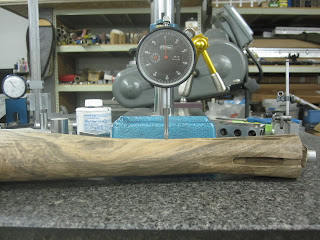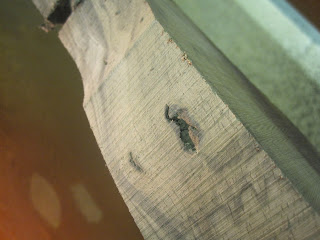The oversized stock is then left to stress relieve for a couple days. For the purpose of this blog posting I set the machined stock on one of our surface plates and zeroed an indicator stem on the top side of the stocks grip and left for the evening. Overnight the indicator shows that the blank has moved .009 laterally. In short the blank has in fact moved or stress relieved itself. Now .009 is nothing to worry about and we have left plenty of extra wood on the OD surface and in the ID of inletting. I have seen shotgun blanks such as this one and full length rifle blanks move as much as an 1/8th of an inch or more in every direction. I think being able to rough machine a blank and allow it to do the mambo before I begin to inlet it has some real advantages, others will disagree, to each his own. Some of the least stable wood I ever cut was turkish being imported and sold to the trade in the mid 80's. I often thought it would sprout leaves and bear nuts when I entered the shop the next morning.
Another advantage to machining a blank versus building one from a blank is being able to find voids, checks, barbed wire and bullets buried within the blank that are not visible when the blank is un-profiled. While most blanks are x-rayed to find any metal buried in a blank to save saw blades at the mill they don't always catch them. The blank in this blog shows a perfect example of a void that was not visible on the exterior of the blank. I have found bark pockets and voids large enough to house a raccoon in some very expensive blanks way under the surface. At least when an internal blemish is found little precious labor is lost and an assessment of the problem can be addressed early in the game.




No comments:
Post a Comment
Note: Only a member of this blog may post a comment.